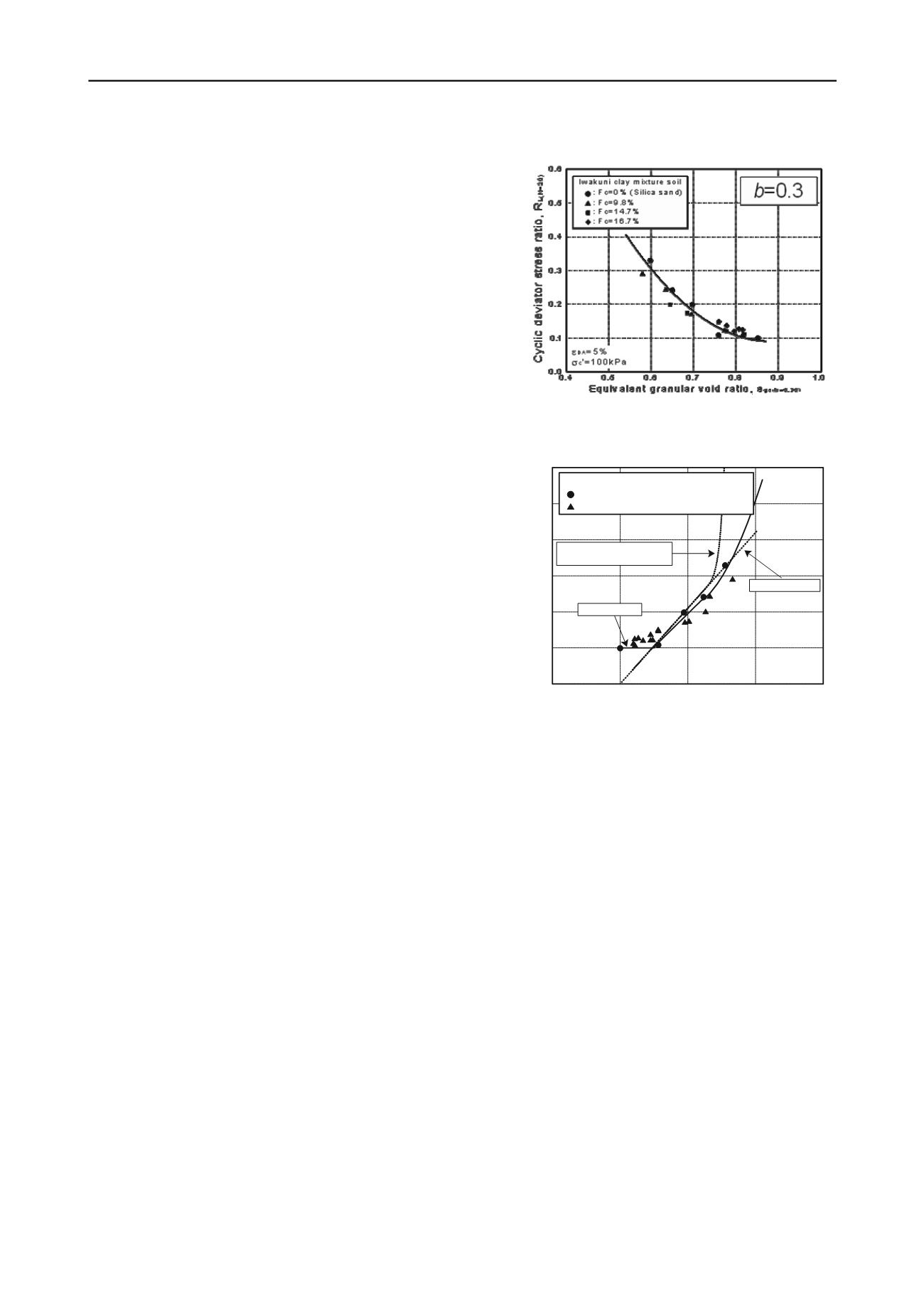
1554
Proceedings of the 18
th
International Conference on Soil Mechanics and Geotechnical Engineering, Paris 2013
where,
e
gmax,
and
e
gmin,
are the maximum and minimum void
ratios of the host sand (without any fines), respectively, and
e
ge
is the equivalent granular void ratio.
In Fig. 6, if the equivalent
void ratio in Fig. 5 is re-calculated by assigning a
D
rge
for sand-
clay mixture, the results indicated that all the data falls within a
small band, including those for clean sand (
F
c
=0%). This was
done for all of the specimens from a clean sand to a sand with
less than 20% fines.
As may be seen from Fig. 6, fairly good correspondence is
recognized between the predicted and experimental results in
spite of various fine contents. It was confirmed that the
proposed model is a reasonable method for liquefaction
resistance of sandy soils subjected to various magnitudes and
equivalent granular relative density.
6 CONCLUSIONS
Undrained cyclic shear tests were performed in order to
investigate the effects of fines content on the liquefaction
strength of sand-clay soils as foundations of dykes and
embankments. The following were the major conclusions
obtained in this study.
Fig.
5 Relationship between cyclic shear strength ratio,
R
L(N=20)
and Equivalent granular void ratio,
e
ge
1. For soil samples with
F
c
>20%, the strength is governed by
the fines, which control the soil matrix.
-50
0
50
100
150
0.0
0.1
0.2
0.3
0.4
0.5
0.6
Equivalent granular relative density, D
rge
Cyclic deviator stress ratio, R
L(N=20)
: Silica sand (Fc=0%)
: Iwakuni clay mixture soil (b=0.30)
Sand-clay mixtures (Fc=0~19.6%)
2. Increasing fines content results in a decrease in cyclic
strength for dense soils, while an increase in strength is
observed for loose soils.
3. As the fines content exceeds
F
c
=19.6%, the cyclic shear
strength increases rapidly, and when fines content is greater
than
F
c
=50%, the liquefaction strength asymptotically
approaches the liquefaction strength of the clay particles.
This is because the fines form the structure of the soil
matrix as the fines content increases.
Specifications for
Highway Bridges (1996)
Ishihara (1977)
Present study
4. When sand particles dominate the soil matrix, a unified
formula representing the cyclic shear strength and
equivalent granular void ratio for the sand-clay mixtures
with various sand structures and fine contents is presented.
7 REFERENCES
Yasuda, S., Harada, K. Liquefaction-induced Damage in the Reclaimed
Lands along Tokyo Bay, Geotechnical Engineering Magazine,
Vol.59, No.7, 38-41(in Japanese).
Fig.
6 Predicted and experimental cyclic shear strength ratio,
R
L(N=20)
when equivalent granular relative density,
D
rge
Georgiannou, V.N., Burland, J.B. and Hight, D.W. (1990) The
undrained behaviour of clayey sands in triaxial compression and
extension, Geotechnique, Vol.40, No.3, .431-449.
Kuwano, J., Nakazawa, H., Sugihara, K., Yabe, H. (1996). Undrained
cyclic shear strength of sand containing fines, Proc., 31
st
Japan
National Conference on Geotechnical Engineering, 993-994 (in
Japanese).
Matsumoto, K., Hyodo, M. and Yoshimoto, N. (1999) Cyclic shear
properties of intermediate soil subjected to initial shear, Proc., 34th
Japan National Conference on Geotechnical Engineering, 637-638
(in Japanese).
Thevanayagam, S., Shenthan, T., Mohan, S. and Liang, J. 2002.
Undrained fragility of clean sands, silty sands and sandy silt, J.
Geotechnical & Geoenvironmental Engineer-ing, 128 (10), 849-859.
Ishihara, K. Soil Behaviour in Earthquake Geotechnics,
1st ed.
,
Oxford
,
Claredon Press
,
1996
.


